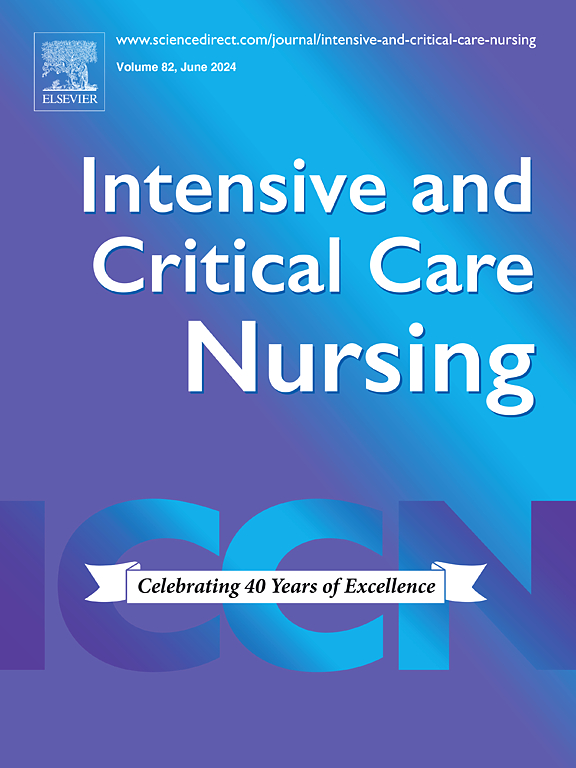Nursing surveillance for clinical deterioration among intensive care unit patients: A scoping review
IF 4.7
2区 医学
Q1 NURSING
引用次数: 0
Abstract
Objectives
To comprehensively examine and summarize the existing knowledge on nursing surveillance for clinical deterioration among intensive care unit patients by presenting study and subject, clinical deterioration, and nursing surveillance characteristics in quantitative and qualitative studies.
Methods
A systematic literature search was conducted in five electronic databases. Literature addressing nursing surveillance for detecting clinical deterioration among adult intensive care unit patients was included. Surveillance identified in quantitative studies was categorized into four nursing data types (scales, assessment records, activity records, and notes). Themes and subthemes were identified from qualitative studies. This review adhered to the Preferred Reporting Items for Systematic reviews and Meta-Analyses extension for Scoping Reviews (PRISMA-ScR) guideline.
Results
Twenty-four sources of evidence were included. Most studies were published since 2012 and conducted in developed countries. Forty-seven clinical deterioration events were identified, and prolonged length of stay was the most frequently identified events. Forty-two surveillance variables were categorized into nursing data types. Assessment records were the most frequently used nursing surveillance variables, yet notes were insufficiently employed. Qualitatively identified surveillance was categorized into six themes: vigilance and monitoring, detection and decision making, integrated documentation practice, collaborative communication, intervention and risk management, and interaction with information technology systems.
Conclusions
The integration of quantitative surveillance data with qualitative elements has the potential to enhance patient safety in intensive care environments. This scoping review offers valuable insights for nursing researchers, educators, practitioners, and stakeholders by presenting a comprehensive understanding of nursing surveillance. By synthesizing evidence that connects surveillance variables with specific nursing data types, this review highlights more effective use of surveillance data in the early detection of clinical deterioration among intensive care patients.
Implications for clinical practice
This paper provides a comprehensive understanding of nursing surveillance, including the utilization of nursing surveillance data and the implementation of nursing surveillance research into clinical practice.
重症监护病房患者临床恶化的护理监测:范围综述
目的通过定量研究和定性研究的研究对象、临床恶化及护理监测特点,全面检查和总结重症监护病人临床恶化护理监测的现有知识。方法对5个电子数据库进行系统的文献检索。包括了有关护理监测检测成人重症监护病房患者临床恶化的文献。定量研究中确定的监测情况分为四种护理数据类型(量表、评估记录、活动记录和笔记)。从定性研究中确定主题和副主题。本综述遵循系统评价和荟萃分析扩展范围评价的首选报告项目(PRISMA-ScR)指南。结果共纳入24个证据来源。大多数研究发表于2012年以后,并在发达国家进行。确定了47个临床恶化事件,延长住院时间是最常见的事件。42个监测变量被分类为护理数据类型。评估记录是最常用的护理监测变量,但未充分利用笔记。定性确定的监测分为六个主题:警惕和监测、发现和决策、综合文件实践、协作沟通、干预和风险管理以及与信息技术系统的互动。结论定量监测数据与定性要素的整合有可能提高重症监护环境中的患者安全。本综述通过对护理监督的全面理解,为护理研究人员、教育工作者、从业人员和利益相关者提供了有价值的见解。通过综合将监测变量与特定护理数据类型联系起来的证据,本综述强调了在重症监护患者临床恶化的早期发现中更有效地使用监测数据。对临床实践的启示本文提供了对护理监测的全面理解,包括护理监测数据的利用和护理监测研究在临床实践中的实施。
本文章由计算机程序翻译,如有差异,请以英文原文为准。
求助全文
约1分钟内获得全文
求助全文
来源期刊

Intensive and Critical Care Nursing
NURSING-
CiteScore
6.30
自引率
15.10%
发文量
144
审稿时长
57 days
期刊介绍:
The aims of Intensive and Critical Care Nursing are to promote excellence of care of critically ill patients by specialist nurses and their professional colleagues; to provide an international and interdisciplinary forum for the publication, dissemination and exchange of research findings, experience and ideas; to develop and enhance the knowledge, skills, attitudes and creative thinking essential to good critical care nursing practice. The journal publishes reviews, updates and feature articles in addition to original papers and significant preliminary communications. Articles may deal with any part of practice including relevant clinical, research, educational, psychological and technological aspects.
 求助内容:
求助内容: 应助结果提醒方式:
应助结果提醒方式:


